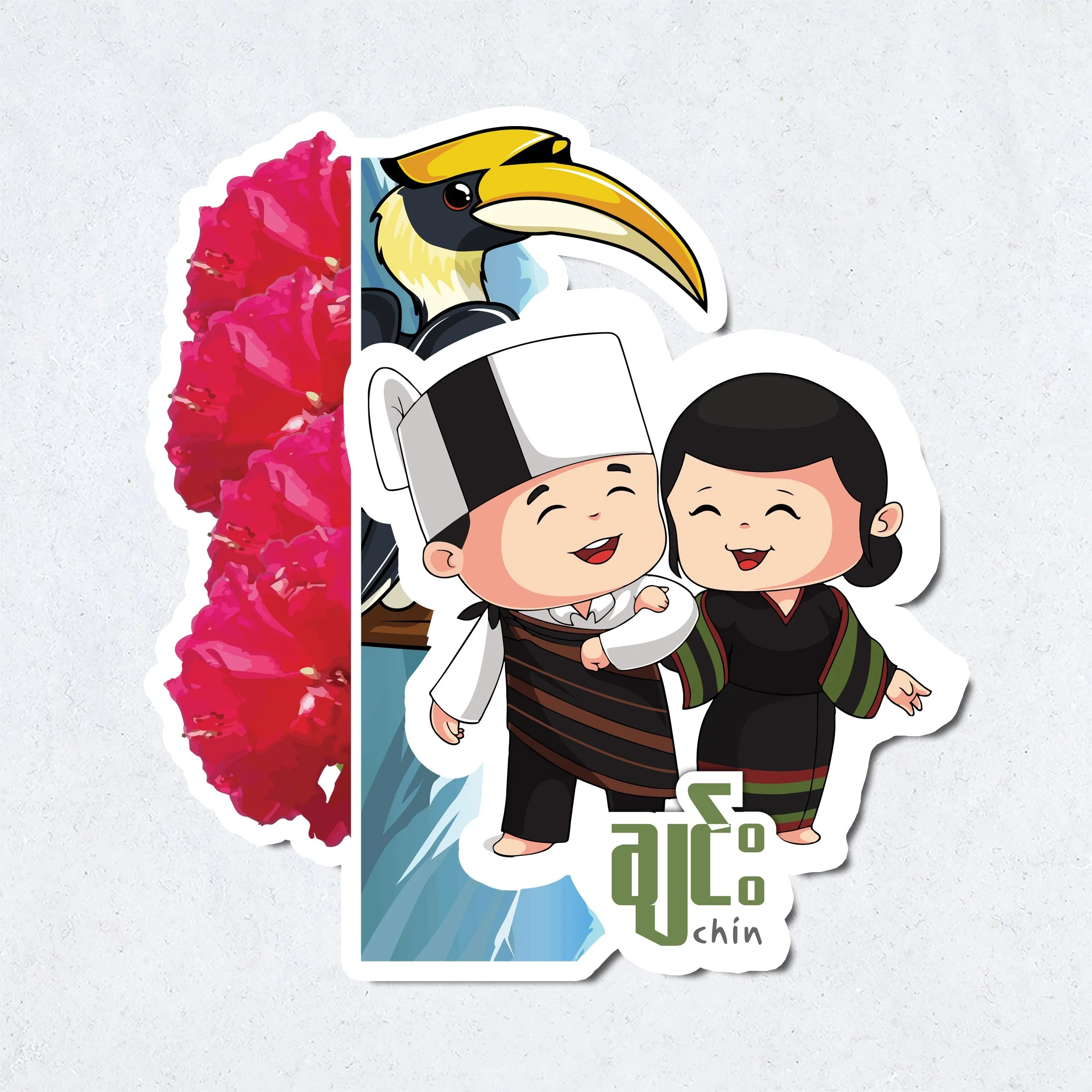Ethnic Nationalities Chin Couple #2 | Spiral Notebook
From shopping lists to writing notes, ideas and poems or turning your imagination and putting it on paper on-the-go, this Spiral Notebook is your perfect companion. This 118 page notebook with ruled line paper is also great for doodling.
Featuring designs that encompass Myanmar’s rich culture and heritage and printed on a durable cover can make you proud to carry it anywhere.
Type: Metal Spiral Notebook
Finish: Matte Front Cover | Black Back Cover
Exclusively designed for you by talented Myanmar designers and creative minds.
From shopping lists to writing notes, ideas and poems or turning your imagination and putting it on paper on-the-go, this Spiral Notebook is your perfect companion. This 118 page notebook with ruled line paper is also great for doodling.
Featuring designs that encompass Myanmar’s rich culture and heritage and printed on a durable cover can make you proud to carry it anywhere.
Type: Metal Spiral Notebook
Finish: Matte Front Cover | Black Back Cover
Exclusively designed for you by talented Myanmar designers and creative minds.
From shopping lists to writing notes, ideas and poems or turning your imagination and putting it on paper on-the-go, this Spiral Notebook is your perfect companion. This 118 page notebook with ruled line paper is also great for doodling.
Featuring designs that encompass Myanmar’s rich culture and heritage and printed on a durable cover can make you proud to carry it anywhere.
Type: Metal Spiral Notebook
Finish: Matte Front Cover | Black Back Cover
Exclusively designed for you by talented Myanmar designers and creative minds.
Product Features
Cover with durable soft-touch coating
118 ruled pages
Every product went through a 3-step quality check system
Size & Weight
Length: 5.98” (15.20 cm)
Height: 7.99” (20.30 cm)
Cover Weight: 300 GSM
Paper Weight: 90 GSM
-
Delivery
Standard (United States) | 5-7 Business Days
Standard (Canada) | 7-10 Business Days
Standard (Rest of the World) | 10-14 Business Days
Direct Shipment from Myanmar | 10-20 Business Days
To ensure quality and customer satisfaction, we use various Suppliers and Fulfilment Partners for our products and orders. As such, delivery times provided here are estimated and might differ based on the number of products in the order to be processed and fulfilled.
You will see the available shipping method and delivery costs in the order checkout.
Order Production
Items are made to order and typically ship within 2-3 business days.
Items sourced directly from Myanmar typically ship within 5-7 business days.
Returns
Return requests can be made within 30 days of your item(s) delivery. Terms & Conditions Apply.
For more information please visit Delivery & Returns.
-
Use a soft, clean, and dry cloth to gently brush any dust or dirt off from the center of the book outwards.
-
History of Modern Chinland
Ref: Chin World By - Salai Van Cung Lian (UK)
The Chin Hills, prior to the British colonization, was an independent nation, free from outside influence. The whole of Chin Hills was dotted with village states on the clan lineage. They had developed a firm and social structure regulated by customary laws which served as a balancing and preserving factor for security and stability.
The majority of the Chins were under a political system of Chieftain rule. The leaders were established by prominence in war or being the father of a clan, which later developed into hereditary rights. While much of Chin Hills practiced Chieftainship, the Tashon tribe in the Falam division practiced a Western-style democratic system, where the leaders were chosen by the people.
After the Second World War, the Chin chiefs took part in negotiations with other ethnics specifically the Shan and the Kachin, and with the Burmese. It was to decide whether Chinland wished to join the Burmese in getting independence from the British Empire and forming a new country.
On 12th February 1947, the three Chin chiefs Pu Hlur Hmung of Falam, Pu Thawng Za Khup of Tedim, and Pu Kio Mang of Hakha, along with representatives of the Shan and the Kachin signed the Panglong Agreement with General Aung San led Burmese at the historic Panglong Conference to create unity in the country. The Chin representatives agreed to join the Burmese and other ethnic groups to gain independence from the British and form the Union of Burma.
After signing the historic Panglong agreement, the British government then set up the Frontier Areas Committee of Enquiry to enquire the will of the hill people on the question of joining Burma.
Representatives from Falam, Hakha, Tedim, Sizang, Kanpetlet, Paletwa testified in front of the committee in Maymyo from 19th – 24th April 1947. On the basis of the Panglong Agreement, negotiations went on, and eventually, Burma gained independence on 4th January 1948 together with frontier areas.
The concept of having a National Day for the Chin people was propounded only after the formation of the Union of Burma. After Burma gained independence, the Chin Special Division and Chin Affairs Council were formed in accordance with the 1947 Constitution of Burma.
The post-independence administration system for Chin State was to be established by the Chin Affairs Council led by Pu Vum Thu Maung. The Chin Affairs Council went through the process of changing the administration system for Chin State from Chieftain rule to a democratic system. A Committee of Enquiry was set up on the 4th February 1948 to enquire which administration system the Chins wished to adopt.
The Chiefs wanted to maintain the status quo, however, the people clearly wanted to abolish chieftain rule and replace it with a democratic system and they didn’t mind granting compensation to Chiefs and Headmen.
On the 20th of February an agenda for Education, Health, and Transportation was first deliberated. Then, the much-awaited and expected issue of abolition of chieftain rule was brought up. The motion to abolish the chieftain system in the Chin Hills and to substitute it with a democratic system was moved by Pu Thang Za Kai of Tedim and was seconded by Pu Sum Mang of Falam and Pu Htang Mawng of Kanpetlet and was approved by 5000 votes to only 17 against. The vast majority of Chin people embraced the modern democratic system of administration in the Chin Hills.
The Chin leaders recognized the importance of unity among the Chin people and the consciousness of the Chin people as a unique race in the world. As nations and people around the world have their own National Day, the Chin Affairs Council decided that it was time for the Chins to have a National Day to celebrate being Chin and to unite the scattered race.
The political concept behind the creation of Chin National Day is – a change for the better in accordance with the changing world, for the perpetual existence of Chins as a unique race.
Chin National Day was officially observed for the first time on the 20th of February 1951 at Mindat with much pomp and ceremony. It was graced by a contingent of dignitaries headed by the Honourable Prime Minister U Nu and other Union of Myanmar leaders.
Throughout the history of Chin National Day, there have been proposals to change the date and attempts to change the name from Chin National Day to Chin Special Division Day or Chin State Day. However, those attempts were unsuccessful as the Chin people were determined to continue to observe their national day as the Chin National Day on February 20th.









































